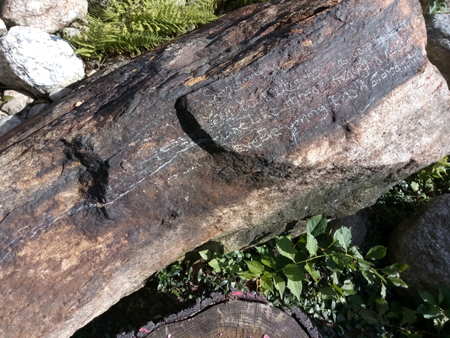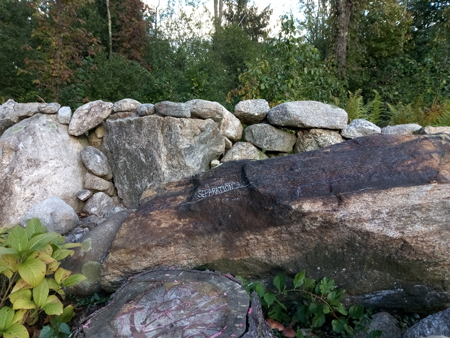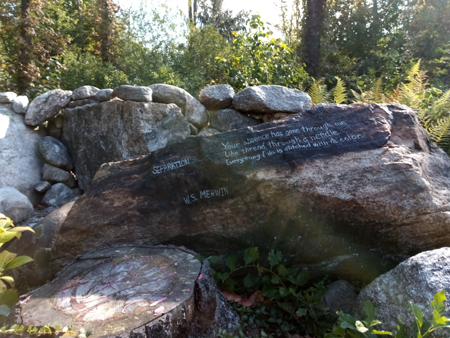When a Rock Is Not Just a Rock.
Dear Reader,
After my sister, Jennie, died in March 2016, John and I created
a garden in the corner of our yard, nestled between two stone
walls. An angel birdbath, given to us by her neighbors, inspired
the idea. John planted dahlias, cosmos and this year, canna
lilies and irises from my brother, Al’s, garden. Another
friend gave us a cherub that fits right in among the plants
and rocks. Tending the garden gives me the opportunity to talk
with my sister and brother. Magical things can happen in a garden
– (see Judy’s Journal, 2020 April, “Scribbling
in Air”).
One day, Beth Sweeney and her husband, Michael Chapman, visited
us, and we stopped at the memorial garden. Beth, who is a poet
and scholar, pointed out a huge rock that anchors the space.

“Look at the white lines going across the rock. They look
like lines that could be written upon.” Here was another
gift of inspiration, this time from a friend. I told Beth about
W. S. Merwin’s poem, “Separation,” which describes
the depth of my grief for Jennie – (see Judy’s Journal,
2019 June, written shortly after I came upon the poem).
I knew some planning had to take place before this rock would
become more than a rock, but a memorial befitting my beloved
sister. By this time, I knew there would be a blog involved,
so I took its picture with my phone. Practicing the lettering
would be essential, so I dug out tailor’s chalk from my
sewing box and wrote on the bumpy surface. Beth was right, the
lines guided me. I saw that it could be done and was glad when
a heavy rain washed away my awkward attempt.

Next step was to ask my friend, bg thurston, also a poet, what
she would recommend using for the lettering. She told me about
pigment pens – markers filled with paint, designed for
writing on surfaces such as stone, wood, terra cotta. Voilà!
However, I was daunted by the permanence of using paint –
what if I made a mistake? I started by writing the title with
the silver-gray marker.

It was too late to back away now, not only because of the significance
of the poem, but I was developing a healthy respect for this
massive, complex rock. I felt puny in its presence and completely
humbled by its grandeur. It was an audacious gesture to contemplate
a change to its mighty surface. I stopped because I needed to
know more and sent an email to a friend, who is a retired earth
science teacher, and asked if he could tell me something about
the rock. Here is some of what he generously took the time to
write:
“I believe it is a metamorphic rock…The ‘lines’
are basically layers of sediment [possibly calcite or quartz]
that have been compressed from top to bottom as you see it.
It could also be positioned upside down…so I am unable
to tell you accurately which side was originally on top. It
was possibly originally formed from sediment on the ocean bottom
with a fair amount of iron (also could be some manganese) that
gives it that rusted appearance. I think it will continue to
darken a bit more over time, as more of the iron comes in contact
with oxygen and water in the environment…glaciers transported
rocks for tens or more miles from their source location. The
age of the rock is certainly many tens of millions of years
old and its transition from the probable seabed was associated
with the bumping, grinding, folding, collapsing, and faulting
involved with the Appalachian and other major deformations along
the Eastern continental border…and its final glacial transport
to this area…”
Whew! His response stunned and gladdened me, especially in his
approximation of the rock’s age. Pathetic fallacy or not,
this is a venerable rock sitting in a garden during what seems
laughingly designated as the year 2021. This rock and one person,
with the help of her friends, united to present a poem expressing
a timeless grief.

